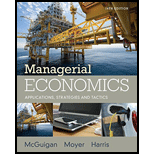
Managerial Economics: Applications, Strategies and Tactics (MindTap Course List)
14th Edition
ISBN: 9781305506381
Author: James R. McGuigan, R. Charles Moyer, Frederick H.deB. Harris
Publisher: Cengage Learning
expand_more
expand_more
format_list_bulleted
Question
Chapter 6, Problem 12E
To determine
To evaluate the current exchange rate represent
Expert Solution & Answer
Want to see the full answer?
Check out a sample textbook solution
Students have asked these similar questions
Solve please and thanks!
Solve please and thank you
NOT USE AI PLEASE
Chapter 6 Solutions
Managerial Economics: Applications, Strategies and Tactics (MindTap Course List)
Knowledge Booster
Similar questions
- (d) Calculate the total change in qı. Total change: 007 (sp) S to vlijnsi (e) B₁ is our original budget constraint and B2 is our new budget constraint after the price of good 1 (p1) increased. Decompose the change in qı (that occurred from the increase in p₁) into the income and substitution effects. It is okay to estimate as needed via visual inspection. Add any necessary information to the graph to support your 03 answer. Substitution Effect: Income Effect:arrow_forwardeverything is in image (8 and 10) there are two images each separate questionsarrow_forwardeverything is in the picture (13) the first blank has the options (an equilibrium or a surplus) the second blank has the options (a surplus or a shortage)arrow_forward
arrow_back_ios
SEE MORE QUESTIONS
arrow_forward_ios
Recommended textbooks for you
 Managerial Economics: Applications, Strategies an...EconomicsISBN:9781305506381Author:James R. McGuigan, R. Charles Moyer, Frederick H.deB. HarrisPublisher:Cengage Learning
Managerial Economics: Applications, Strategies an...EconomicsISBN:9781305506381Author:James R. McGuigan, R. Charles Moyer, Frederick H.deB. HarrisPublisher:Cengage Learning Economics (MindTap Course List)EconomicsISBN:9781337617383Author:Roger A. ArnoldPublisher:Cengage Learning
Economics (MindTap Course List)EconomicsISBN:9781337617383Author:Roger A. ArnoldPublisher:Cengage Learning

 Managerial Economics: A Problem Solving ApproachEconomicsISBN:9781337106665Author:Luke M. Froeb, Brian T. McCann, Michael R. Ward, Mike ShorPublisher:Cengage Learning
Managerial Economics: A Problem Solving ApproachEconomicsISBN:9781337106665Author:Luke M. Froeb, Brian T. McCann, Michael R. Ward, Mike ShorPublisher:Cengage Learning

Managerial Economics: Applications, Strategies an...
Economics
ISBN:9781305506381
Author:James R. McGuigan, R. Charles Moyer, Frederick H.deB. Harris
Publisher:Cengage Learning

Economics (MindTap Course List)
Economics
ISBN:9781337617383
Author:Roger A. Arnold
Publisher:Cengage Learning



Managerial Economics: A Problem Solving Approach
Economics
ISBN:9781337106665
Author:Luke M. Froeb, Brian T. McCann, Michael R. Ward, Mike Shor
Publisher:Cengage Learning
